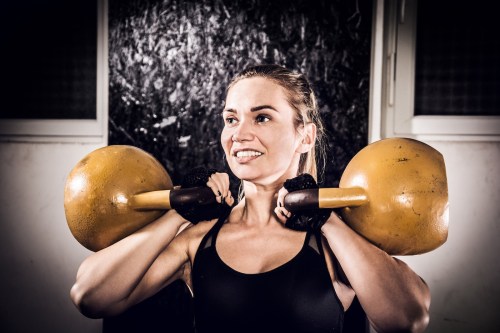Without a doubt, strength training is great for your body—it builds muscle, keeps your metabolism up and ticking, and lowers the risk of osteoporosis and other health conditions later in life. However, if you’re noticing chronic pain or if you find yourself more injury-prone after lifting that forty-pound barbell, you might be overdoing it, and all that good work could start to backfire.
What’s more, even without a clear red flag that you’re lifting heavier than you should, there are times when picking a lighter set of weights will provide greater benefits for your fitness endeavors. Unsure of when to take it down a notch? Here’s your ultimate guide to when you should grab a pair that’s below what you’ve been lifting, according to experts.
If you’re learning an exercise
Even if you’ve been lifting twenty-pound dumbbells for a squat military press, if you want to try out a renegade row, it’s not a bad idea to opt for a lighter set of weights first while you’re learning the move. In fact, while learning the mechanics of a posture, you should always plan to drop the weight you’re lifting, according to Sara Mastantuono, CSCS and Equinox trainer. This allows you to build technique without distraction from added resistance.
And this rings especially true when the move you’re learning works several muscle groups. “It’s important to start with lighter, more manageable weight when learning complex movements. Because these movements are multiplanar and demand multi-joint coordination, there are more degrees of freedom when performing,” she says. If the load is too great, chances of injury increase.
If form begins to suffer
You don’t want to keep lifting heavy weights if it’s throwing off your form and balance, as improper placement can set you up for injury and it’ll make it hard to effectively see results from the work, explains Lauren Lobert, DPT, OMPT, CSCS and owner of APEX Physical Therapy.
You should be able to use full range in motion for the exercise without any discomfort or limitation. “If you aren’t able to perform the exercise in a controlled manner with full range of motion, lighter weight is appropriate,” she says. You can watch yourself perform the exercises in a mirror, noting when form begins to suffer. You can also ask a trainer at the gym or a workout buddy to hold you accountable.
If you’re working smaller muscle groups
If you’re trying to work smaller muscle groups, like your triceps, or performing isolation exercises, lighter weights might be the best vehicle to get you there. Lifting lighter prevents the larger muscle groups from stepping in to help. Yet you’ll want to increase rep count when doing so, too. “To get the same results lifting smaller weights, you have to do more reps. If you want to gain muscle, which is necessary for ‘toning,’ you need to go to fatigue,” says Lobert. That means, you must progressively overload your muscles by adding repetitions, changing the speed and intensity, or using more weight, she says. If you choose to keep the same weight or even lighten it up a bit in order to add on those repetitions or go faster, you totally can.
“If you are not comfortable lifting heavier weights, then slowing down or speeding up your movements, adding pauses at the bottom of the repetition, or adding more repetitions is a great option,” she says. “By going to fatigue, you can still gain muscle. This means you don’t have to lift big, heavy weights to see results,” she says. So, if you are lifting lighter, that’s great—however if you aren’t getting results you want and don’t feel tired after those repetitions, you might want to consider going a bit heavier after all.
If you’re super sore
First off—being sore is a good thing. It means you’re improving performance and getting stronger, working different muscles. However, while you shouldn’t stop training altogether, you should go lighter in weights for exercises that directly target those muscles until the soreness wears off. “Muscle soreness is normal when doing new exercises or certain exercises that work your muscles in their maximally stretched and lengthened positions,” says Lobert. Yet greater soreness does not mean greater progress. “When you’re sore, you want to keep moving but avoid doing heavy lifting that targets the muscle groups that are sore,” she says. This can set you up for injury and take you out of the game for longer than you’d like.
If you’re injured or in recovery
If you’re injured and are getting back into your fitness regimen, don’t pick up the same weights you were lifting prior to the accident. Your body has not adjusted quite yet. “As you go back to working out a certain body part after being injured, it is recommended that you start lighter than what you were doing before you were injured,” says Lobert. There is no set timeframe as to when it is appropriate to get back to the gym, as it depends on the injury and the person; however, a good rule is to start cautiously.
What’s more, you should also seek guidance from your PT. “If you are injured, you should speak with your physical therapist about if you should be doing a particular exercise, especially if it is painful. They may be able to show you modifications or other exercises that are better to do to work the same muscles while your injury heals,” she adds.
If you’re more focused on endurance
If you are trying to use weight training as a way to boost cardiovascular and muscle endurance, going lighter might help, says Mastantuono. For instance, if you are a runner, cyclist, or endurance athlete, like a soccer player, you might be training for higher repetition moves and are more focused on building endurance and aerobic capacity. In these cases, choosing a lighter load will get you towards your fitness goals faster.
Once you’ve got your weight training down, don’t forget to foam roll—because, FYI, skipping out on recovery could be why you’re not getting stronger.
Sign Up for Our Daily Newsletter
Get all the latest in wellness, trends, food, fitness, beauty, and more delivered right to your inbox.
Got it, you've been added to our email list.











